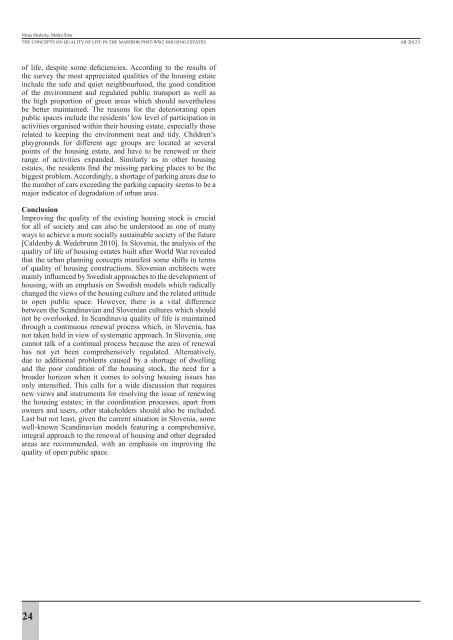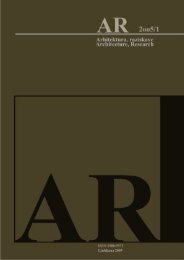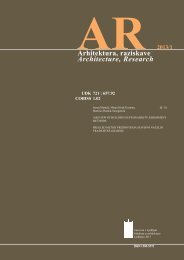2o12/1 - Fakulteta za arhitekturo - Univerza v Ljubljani
2o12/1 - Fakulteta za arhitekturo - Univerza v Ljubljani
2o12/1 - Fakulteta za arhitekturo - Univerza v Ljubljani
Create successful ePaper yourself
Turn your PDF publications into a flip-book with our unique Google optimized e-Paper software.
Vanja Skalicky, Metka SitarThe Concepts on Quality of Life in the Maribor post-WW2 Housing EstatesAR 2012/1of life, despite some deficiencies. According to the results ofthe survey the most appreciated qualities of the housing estateinclude the safe and quiet neighbourhood, the good conditionof the environment and regulated public transport as well asthe high proportion of green areas which should neverthelessbe better maintained. The reasons for the deteriorating openpublic spaces include the residents’ low level of participation inactivities organised within their housing estate, especially thoserelated to keeping the environment neat and tidy. Children’splaygrounds for different age groups are located at severalpoints of the housing estate, and have to be renewed or theirrange of activities expanded. Similarly as in other housingestates, the residents find the missing parking places to be thebiggest problem. Accordingly, a shortage of parking areas due tothe number of cars exceeding the parking capacity seems to be amajor indicator of degradation of urban area.ConclusionImproving the quality of the existing housing stock is crucialfor all of society and can also be understood as one of manyways to achieve a more socially sustainable society of the future[Caldenby & Wedebrunn 2010]. In Slovenia, the analysis of thequality of life of housing estates built after World War revealedthat the urban planning concepts manifest some shifts in termsof quality of housing constructions. Slovenian architects weremainly influenced by Swedish approaches to the development ofhousing, with an emphasis on Swedish models which radicallychanged the views of the housing culture and the related attitudeto open public space. However, there is a vital differencebetween the Scandinavian and Slovenian cultures which shouldnot be overlooked. In Scandinavia quality of life is maintainedthrough a continuous renewal process which, in Slovenia, hasnot taken hold in view of systematic approach. In Slovenia, onecannot talk of a continual process because the area of renewalhas not yet been comprehensively regulated. Alternatively,due to additional problems caused by a shortage of dwellingand the poor condition of the housing stock, the need for abroader horizon when it comes to solving housing issues hasonly intensified. This calls for a wide discussion that requiresnew views and instruments for resolving the issue of renewingthe housing estates; in the coordination processes, apart fromowners and users, other stakeholders should also be included.Last but not least, given the current situation in Slovenia, somewell-known Scandinavian models featuring a comprehensive,integral approach to the renewal of housing and other degradedareas are recommended, with an emphasis on improving thequality of open public space.24

















